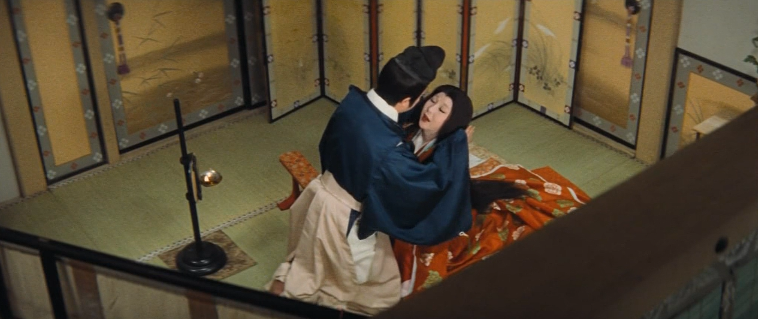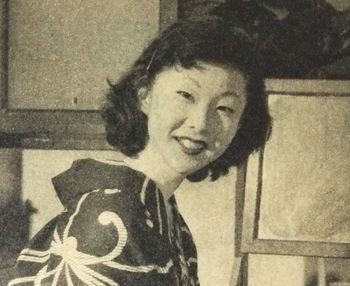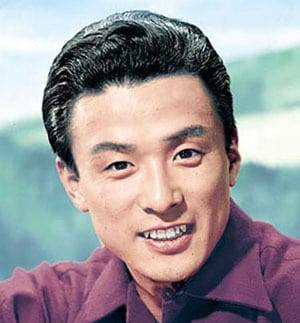Physical Address
304 North Cardinal St.
Dorchester Center, MA 02124

Other titles: Love, Thy Name Be Sorrow; Forbidden Love, Love Not Again (alternate English titles); Love, love, don’t play with love (approximate literal English title);1 La renarde folle [“the mad fox”] (Venice Film Festival French-language title); La volpe folle [“the mad fox”] (Venice Film Festival Italian-language title)
| Production Company | Tōei (Kyoto) |
| Scenarist | Yoda Yoshikata |
| Source | Bunraku and Kabuki plays (performed 1734 and 1735, respectively), Ashiya Dōman Ōuchi Kagami (Mirror of the Imperial Court During the Time of Ashiya Doman) by Takeda Izumo I [uncredited] |
| Producer | Okawa Hiroshi |
| Planning | Tamaki Junichirō |
| Cinematographer | Yoshida Sadaji |
| Art Director | Suzuki Takatoshi |
| Music | Kinoshita Chūji |
| Editing | Miyamoto Shintarō |
| Performers | Ōkawa Hashizō (Abe no Yasuna); Saga Michiko (Sakaki, Kuzo-no-ha, Kon); Tsukigata Ryunosuke (Gen. Onono); Hidaka Sumiko (Yasunori’s wife); Amano Shinji (Doman); Yamamoto Rin’ichi (Akuemon); Usami Junya [a.k.a., Jun] (Kamo no Yasunori); Kato Yoshi (Squire Shoji); Kawarazaki Chōichirō (Crown Prince); Susukida Kenji (fox grandfather); Ozawa Eitarô (Iwakura Daisuke) |
| Status | Extant |
| Photography | Color |
| Format | 35 mm. |
| Ratio | 2.35 : 1 (Toeiscope) |
| English subtitles | Yes |
| Original release date | May 1, 1962 |
| Length | 109 minutes |
| Festival and retrospective screenings / publications / home video | 1962 Venice Film Festival Golden Lion (nominee); Tokyo FILMeX (2004); 55th International Film Festival Berlin (“Berlinale”) Special Screening (2005); IFFR (International Film Festival of Rotterdam, 2005); “75 Hidden Gems – The Great Films Time Forgot” – Sight & Sound Magazine [UK] (August 2007); MOMA Retrospective (2016); Venice Film Festival Retrospective screening (2018); U.S. Blu-ray release (2020) |
In a prologue, illustrated by an unfurling scroll, it is related that, during the time of the Emperor Suzaku (10th Century A.D.), the Kyoto court astrologer Komo no Yasunori had been instructed by an oracle to adopt a girl-child. Yasunori had sent his two disciples, Abe no Yasuna and Ashiya Dōman, in search of a girl born in the “year, direction and day” of the Sheep. In a village called Izumi, they discover twin sisters Sakaki and Kuzu-no-ha who were both born in the appropriate year and direction and on the correct date. The two young men return to Kyoto with the older twin Sakaki, leaving Kuzu-no-ha behind.
Ten years later, after Sakaki has reached womanhood in Yasunori’s household, a volcanic eruption from Mt. Fuji has made the sky and everything else, even people’s clothing, appear a bright shade of red, and a white rainbow is observed crossing the path of the moon. Yasunori fears that “the realm will be split in two” because of panic engendered by these omens. To interpret these disturbing signs, the astrologer consults an ancient Chinese scroll called the Golden Crow. This document is so valuable that it can only be accessed when the two people who have sole charge of the keys – namely, Yasunori’s wife and Sakaki – unlock the shrine and the small chest, respectively, in which the precious scroll is doubly guarded.
Reading the scroll, Yasunori interprets the white rainbow as signifying that the Crown Prince is cursed… but does not elaborate. Putting the Golden Crow back in the locked chest and shrine, Yasunori announces that he will travel to the Emperor’s palace to personally inform the Chancellor of the secret details of the prophecy.
Meanwhile, although Yasunori’s faithful disciple Abe no Yasuna had arrived on time to assist him, his other disciple, Ashiya Dōman, is late, because he had stopped at the emperor’s court to say flattering words about the astrologer. Yasunori expresses his displeasure both at Dōman’s lateness and his presumption, saying that “no one who disgraces me shall be my successor.” Before the astrologer leaves for the palace, however, his wife warns his chief servant, Akuemon, to beware of bandits on the way.
Yasuna and Sakaki meet privately. Sakaki, who is in love with Yasuna, is pleased that the old astrologer appears to prefer him to Dōman, though Yasunori has never officially named either disciple as his successor. This meeting is witnessed from another room by Yasunori’s wife and her lover, Dōman. She is jealous that Dōman is attracted to Sakaki, and expresses contempt for the low-born young woman.
On the road to the palace, Akuemon, taking Yasunori’s wife’s “warning” as a signal, kills both the guards and Yasunori. When the astrologer’s body is brought back, Akuemon blames his death on an attack by bandits. The dead man’s widow feigns anger and sorrow.
A court official arrives to inquire as to the old man’s death. The astrologer’s widow informs him, truthfully, that Yasunori died without naming a successor. Dōman then volunteers to interpret the contents of the Golden Crow at the palace, a suggestion which his lover, the widow, approves. Yasuna also asks to give his interpretation of the meaning of the scroll, but Sakaki interrupts to volunteer to go to the palace herself to perform this task, as she claims that the old astrologer had also trained her. Later, Yasuna and Sakaki meet alone and pledge their love for one another.
At the palace, Sakaki is questioned about Yasunori’s prophecy. She correctly relates the astrologer’s interpretation of the scroll, but also claims, falsely, that the late master had verbally named Yasuna, not Dōman, as his successor. (However, he was clearly leaning in that direction.) The Emperor decides that both men should draw lots in Yasunori’s household to determine which disciple should interpret the Golden Crow.
In the presence of several officials, the chest containing the scroll is retrieved from the shrine. Yasuna and Dōman are about to draw lots when Sakaki uses her key to open the chest, only to discover that it is empty: the Golden Crow is missing. The widow accuses Sakaki of having stolen it but she adamantly denies this. Yasuna, pointing out the suspiciousness of recent events, including the murder of Yasunori, supports Sakaki.
Sakaki is tortured by Akuemon, while Yasuna, imprisoned nearby, watches helplessly. Yasunori’s widow tells Yasuna that she will send for the constable tomorrow to arrest him as an accomplice in the theft of the scroll and thus he will never see Sakaki again. The widow and Akuemon withdraw, leaving the tormented couple alone.
A lady-in-waiting arrives to help Sakaki, but it is too late: she has died from torture. This servant frees Yasuna, who weeps over Sakaki’s body. Back in the widow’s chambers, she tells Dōman that she had kept the scroll hidden in the sleeve of her robe the whole time. She had stolen from Sakaki the key to the chest and made a copy, replacing the original key in the young woman’s bag before the theft could be discovered.
Yasuna enters and sees Dōman and the widow with the stolen scroll. In her fear at the sight of him, the widow recoils, knocking over a lamp that sets fire to a curtain, and this blaze soon spreads through the room. Dōman, terrified of the flames, flees. Yasuna seizes the scroll from the widow, who collapses and is burned to death. Yasuna with the scroll wanders through the house, now engulfed in flames, talking to Sakaki as if she were alive because he has gone mad.
The insane Yasuna, his hair long and disheveled, wanders the countryside. He prays at a roadside shrine for the return of his beloved Sakaki, or “someone who looks like her.” In a field of yellow flowers, he performs a dance expressing his love and grief. He wraps Sakaki’s kimono around his head and collapses on the ground in despair.
In a meadow near the village of Izumi, Sakaki’s twin sister, Kuzo-no-ha, is seen picking flowers. Yasuna, sleeping nearby, awakens, spots Kuzo-no-ha and joyously approaches her, mistaking the girl for her deceased twin. She recoils in fear, but her father, Squire Shoji, recognizes Yasuna. The family resolves to bring the madman back to live with them until he recovers his senses.
In the capital, the Crown Prince holds a meeting with his advisors to discuss the unrest occurring throughout Japan. There are rumors among the people that Mt. Fuji will erupt, Kyoto, the capital, will be inundated and the realm will be split in two. The advisors scoff at these rumors, but the Crown Prince, wishing to quash them, commands that Yasuna and the scroll be located immediately.
Privately, Minister of Civil Affairs Iwakura, the dead widow’s brother, informs Dōman of his intention to seize the Golden Crow in order to use it to “rule people’s hearts,” and reveals that when he finds the mad Yasuna, he will execute him. Dōman relates a prophecy he had read in the scroll, whereby the “blood of a live white vixen” would allow the Crown Prince to beget a child, breaking the curse. Akuemon, who now works for Iwakura, assures him that the woods around Izumi, where he was born, are teeming with foxes. Iwakura orders Akuemon to “go fox hunting.”
In Izumi, Yasuna, Kuzu-no-ha and a lady-in-waiting are walking through a meadow where some peasants are dancing. Yasuna wishes to join the peasants in their dance, but Akuemon’s hunters enter, scattering the peasants. Kuzu-no-ha leads the confused Yasuna away.
Taking a path through the woods, Yasuna and the two young women encounter an old woman who collapses with an arrow lodged in her back, which Yasuna removes. Akuemon’s hunters approach them, astonished that what they thought was a fox was actually a woman. Yasuna ridicules them for not being able to tell an animal from a person, and departs with the injured woman.
Yasuna, assisted by the lady-in-waiting and Kuzu-no-ha, helps the old woman return to her humble hut. An old man at the entrance, her husband, thanks Yasuna for saving his wife’s life. The injured old woman, who has entered the hut, collapses. Her face now appears as that of a fox, revealing that she is a kitsune: a spirit-fox capable of assuming human form.
Her granddaughter, Kon, who is also a kitsune, enters from another room, and the fox grandmother explains that a young human had just saved her life. Kon, unseen by Yasuna, observes him standing near the entrance, and is attracted to him. As the family is now indebted to Yasuna, Kon’s grandparents order her to follow Yasuna at a distance to make sure he is safe.
As Yasuna is returning home, he and the two women are set upon by Akuemon and his men. Akuemon finds the Golden Crow on Yasuna’s person and steals it, and it seems that Yasuna is about to be killed. Kon, witnessing this from a distance, calls out for help. An army of foxes appear, and as they approach, they assume human form and attack Akuemon and the hunters with farmers’ implements. A fox spirit seizes the Golden Crow from Akuemon and flies away, carrying it off in its teeth. Kon and her grandfather similarly rescue Yasuna.
Kon, the fox grandfather, and the still-unconscious Yasuna materialize under a tree at night. The grandfather tells Kon that it is her duty to nurse Yasuna back to health. When Kon confesses her attraction to Yasuna, the grandfather warns her that “a debt is a debt, but a foe is a foe”: humans, even the “good” Yasuna, are the born enemies of foxes. If she turns her back on her fox nature and embraces a human lover, she will walk the earth alone, rejected by both foxes and humans.
Yasuna and Kon are transported to a cave-like house, where Kon assumes the form of Kuzu-no-ha and treats Yasuna’s wounds by licking them with her tongue. The still-mad Yasuna regains consciousness and misidentifies the disguised Kon as Sakaki, though she claims to be Kuzu-no-ha. He kisses the fox-woman and she falls in love with him.
Several years have passed. Kon, still disguised as Kuzu-no-ha, is working at a loom in a hovel where she lives with Yasuna and their infant half-fox child. In a moment of relative lucidity, Yasuna tells Kon that he must return to Kyoto with the Golden Crow, but she dissuades him, for fear of her deception being exposed. She sends Yasuna off to the woods to chop firewood.
While Yasuna is away, Squire Shoji approaches the hut with his wife and the real Kuzu-no-ha. Shoji hears Kon working at her loom, and when he approaches, is amazed at the resemblance between the weaving woman and his daughter.
Yasuna returns with the firewood. He assumes that Squire Shoji is playing a trick on him by dressing Kuzu-no-ha to appear as if she had traveled a long distance to see him. But when he sees Kon still weaving at her loom, he collapses in agonized confusion.
Kon locks herself in her room with the child and reveals to Yasuna that his “wife” is actually a fox in human form. She begs Kuzu-no-ha’s forgiveness for impersonating her, and using a pen she holds in her mouth, writes a waka poem on the shoji screen with a message to Yasuna: “If you love me, come visit me in Izumi, in the forest of Shinoda. There Kuzu-no-ha waits in sorrow.”
Kon then resumes her animal form and flies away, leaving the infant behind, as the hut collapses and disappears. All that remains is a field of grass, as if the hut had never existed. Yasuna finally grasps what has happened, and, coming to his senses, for the first time addresses Kuzu-no-ha correctly by name. He then finds the Golden Crow, which Kon had hidden in the infant’s bedclothes. He smiles with tears in his eyes.
We flash back to the scene in which the mad Yasuna dances in a field of saffron-colored flowers. As before, he pulls Sakaki’s kimono over his head and collapses on the ground. His lifeless form is replaced by a stone monument next to a field of dried grass, over which a single tongue of flame, symbolizing the kitsune, hovers.

Saga Michiko, the daughter of the distinguished actress Yamada Isuzu (The Horse Boy), enjoyed a prolific career, starting in the early-1950s, when she was still in her teens, and lasting into the mid-1970s. In the same year, 1962, in which she appeared in this film, she starred in The Body (Ratai), directed by Uchida screenwriter Narusawa Masashige (Chikamatsu’s Love in Osaka). She also appeared in the final installment of Inagaki Hiroshi’s Miyamoto Musashi (a.k.a., Samurai) trilogy, as well as in films by younger filmmakers, such as Yoshida Yoshishige, Jissōji Akio and Ishii Teruo. She died in the Philippines in 1992 at age 58.

Ōkawa Hashizō was one of the three most popular young male period-film stars of his generation, along with Ichikawa Raizō and Nakamura Kinnosuke (later Nakamura Yorozuya). Trained as a Kabuki actor, he made his film debut in 1955. Ōkawa appeared in films by such directors as Ōshima Nagisa (Amakusa Shirō Tokisada (The Revolutionary, 1962)), Katō Tai (Bakumatsu zankoku monogatari (Cruel Story from the End of the Shogunate, 1964) and Kaze no bushi (Warrior of the Wind, 1964)) and Ishii Teruo (Gokinzo yaburi (The Shogun’s Vault, 1964)). In his final film, released in 1967, he played the role of the popular Edo-period detective Heiji, created in 1931 by the novelist Nomura Kodō. For 18 years, from 1966 until his death from cancer in 1984, Ōkawa played this same detective character in a long-running television series, Zenigeta Heiji, for a total of 888 episodes. According to the Guinness Book of World Records, this is the longest run ever for a single actor in an hour-long TV show.
(Continued on Page 2)
[…] additional notes on Uchida’s ongoing interest in animation, see my review of The Mad Fox, another film in which animals turn into humans and back […]
[…] The Mad Fox Aug 14, 2021 / 8:06 am Reply […]